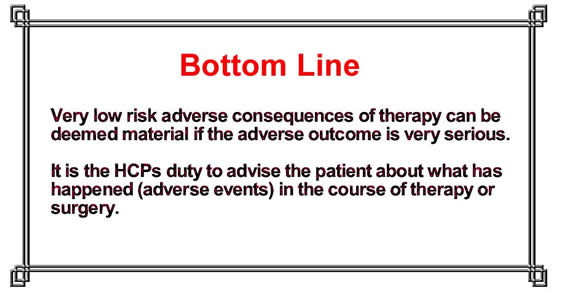Informed Consent
Causation
The plaintiff must show that on a balance of probabilities, if properly informed, they would not have taken the risk and had the therapy. They have to show that the information would have altered their decision making.
Informed consent sounds in negligence:
- Duty to give full informed consent = standard of care
- Failure to meet standard of care -> causation -> injury.
Negligence:
- if consent is given, but not informed.
Battery:
- only if there is no informed consent at all
- surgery/therapy is beyond what was in the consent.
Stamos v Davies. (1985 - Ontario High court of justice).
In the course of a lung biopsy, the plaintiff 's spleen was injured necessitating a splenectomy (surgery to remove his spleen), a few days later.
Negligence alleged:
- Failure to obtain an informed consent
- Failure to perform the biopsy in accordance with a reasonable standard of care
- Falling below a reasonable standard of post-biopsy care
- Failure to advise what had happened during the course of treatment (that the spleen had been entered).
- Failure to advise the plaintiff that the doctor had entered the spleen was a breech of duty
The court held that there was a breach in the standard of care. The enhanced risk of hitting the spleen should have been discussed, but no liability was found for that breach as causation could not be demonstrated. The plaintiff had serious underlying disease and any reasonable person would have opted to have the biopsy.
It was held that the HCP must disclose all material risks and any special or unusual risks.
The failure to communicate was emphasized in this case and was held to be a breech of standard of care. The enhanced risk of hitting spleen should have been discussed.
A new duty emerged from this case: To advise what has happened in the course of therapy/surgery.
But there was no liability for the breech in duty, as causation could not be demonstrated. Any reasonable person in the patient’s position would have opted to have the biopsy as patient had serious underlying disease.
What is a Material risk and more about causation
Arndt v. Smith, [1997] 2 S.C.R. 539
The patient contacted chickenpox in the 12th week of pregnancy and saw her family doctor for advice about the risk of this infection damaging the foetus. The family doctor advised about the 2- 3% risk of skin and minor limb problems but did not advise about the very small risk of serious congenital anomalies. The risk of this occurring was estimated to be less than 0.5% risk (roughly 0.2%). Sadly the child was born with severe damage secondary to the chickenpox infection.
The patient sued for negligence on the grounds that had due disclosure been made, she would have terminated the pregnancy and so been spared the burden of care for a disabled child.
The court ruled that the standard of care had been breached but causation could not be demonstrated. Would the mother have gone ahead with the pregnancy if she had been given the information about the very small risk of serious congenital abnormalities secondary to chickenpox?
Trial Court: (1995 - British Columbia, Canada) Dismissed the case on causation.
Appeal Court: Causation was found and damages were awarded. What is lost is the ability to choose. Breach of fiduciary duty to not provide this information is equivalent to injury. No causation needed.
Supreme Court: Upheld the modified objective test from Reibl v Hughes. The judge rejected the general application of the fiduciary label. The court ruled that had she known about this very small risk, she would still have continued with the pregnancy. The pregnancy was much desired and the risk was very small.
Fiduciary duty could only be used in special circumstances such as fraudulent misrepresentation and abuse of power.
The HCP should have discussed the very small risk of serious congenital anomalies as a result of chickenpox, but no liability was found for this breach in care.


